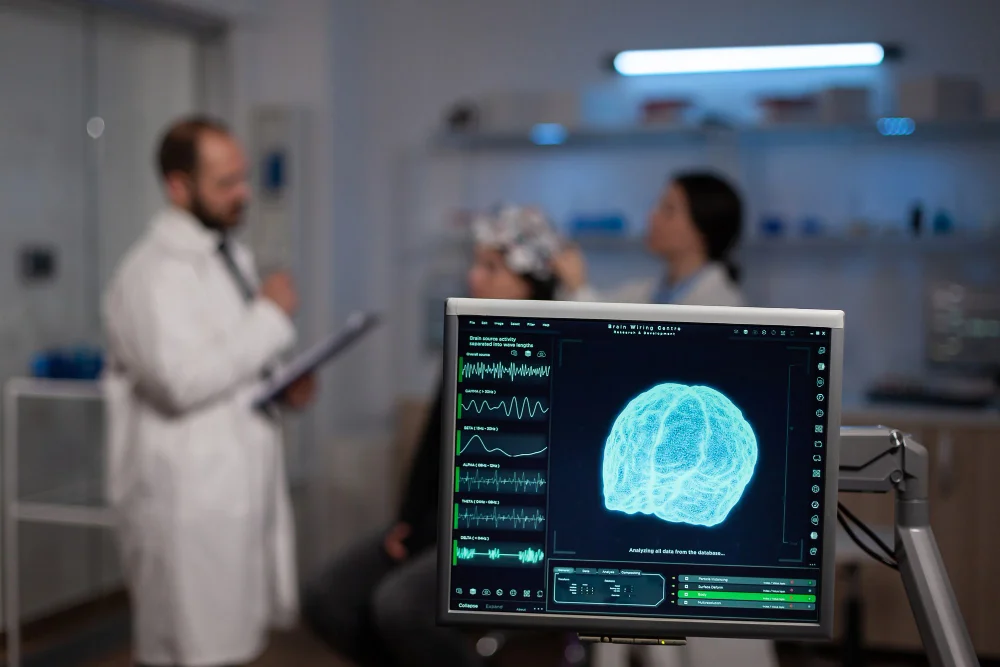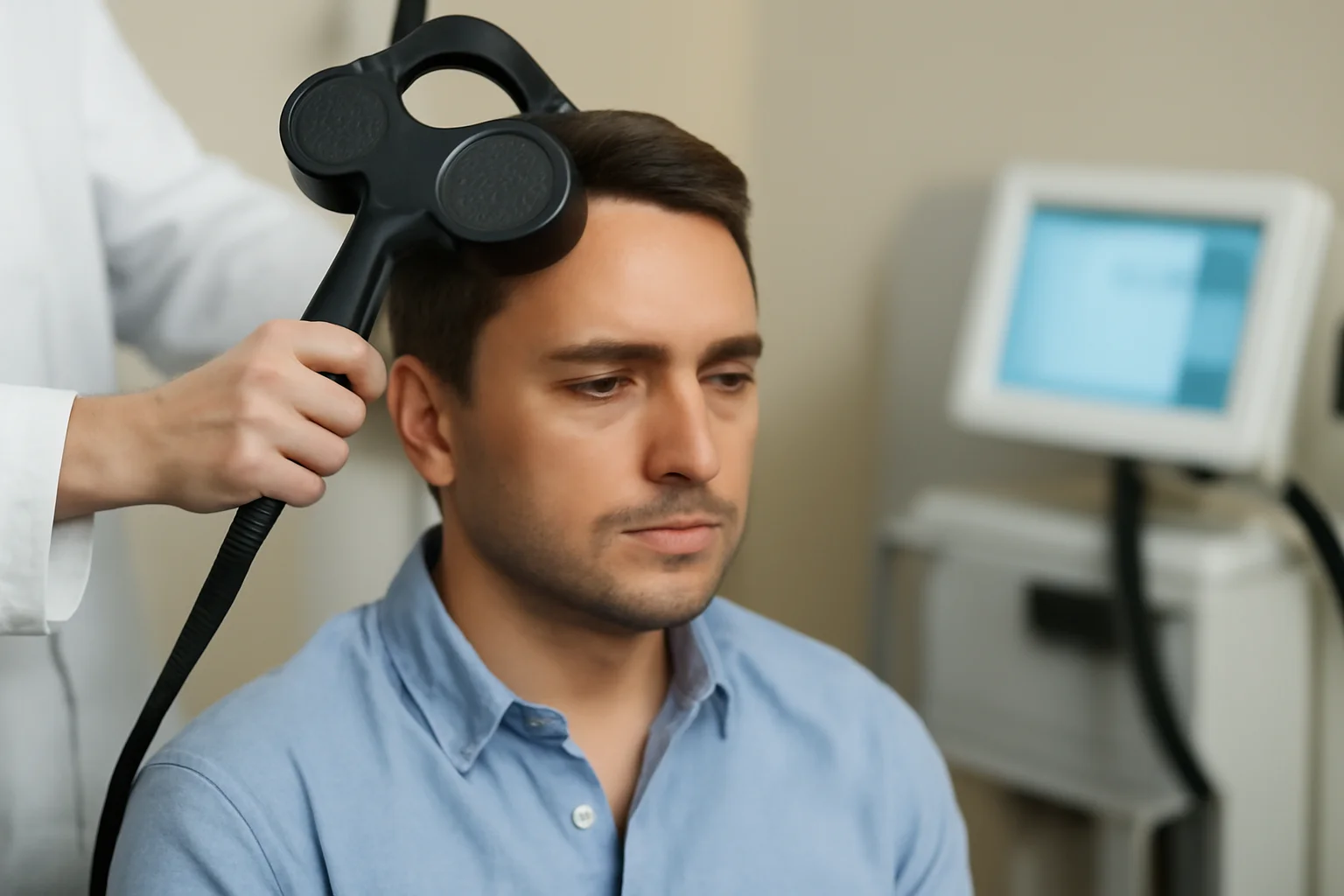Transcranial Magnetic Stimulation (TMS) has emerged as a promising treatment for depression, anxiety, and other mental health conditions that don’t respond well to traditional therapies. As more people consider this option, understanding both the potential benefits and the risks of TMS becomes necessary for making informed decisions.
TMS works by using magnetic pulses to stimulate specific areas of the brain responsible for mood regulation and emotional control. Unlike medications that affect the entire body or electroconvulsive therapy (ECT) that causes seizures, TMS targets precise brain regions without requiring anesthesia or causing memory loss.
The treatment involves placing a magnetic coil against your scalp, where it delivers focused magnetic pulses that activate underactive neurons in areas associated with depression.
What is TMS Therapy and How Does It Work?
During a TMS session, you sit in a comfortable chair while a technician positions a magnetic coil against your head. The device generates magnetic pulses that pass through your skull and stimulate nerve cells in the targeted brain region. Each pulse creates a clicking sound and causes a tapping sensation on your scalp.
A typical TMS treatment course involves daily sessions lasting 20-40 minutes, five days per week, for four to six weeks. The magnetic field strength is similar to that of an MRI machine, but focused on a smaller area. This precision allows doctors to target the dorsolateral prefrontal cortex—the brain region most commonly associated with depression—without affecting surrounding tissue.
Understanding the Risks of TMS Therapy
Common TMS Risks
The most frequently reported risks of TMS are mild and temporary. Headaches occur in about 40% of patients, especially during the first few sessions. These headaches typically respond well to over-the-counter pain relievers and often decrease as treatment continues.
Scalp discomfort at the treatment site affects approximately 30% of patients. This sensation ranges from mild tingling to a more noticeable tapping feeling during pulses. While uncomfortable for some, most people adapt to the sensation within a few sessions.
Facial twitching or jaw tension can occur when the magnetic pulses inadvertently stimulate nearby facial muscles. This happens in about 20% of patients but is generally mild. Adjusting the coil position usually resolves this issue.
Lightheadedness or dizziness affects roughly 10% of patients, typically immediately after treatment. These symptoms are brief and resolve within minutes.
Severe TMS Therapy Risks
The most serious risk of TMS therapy is seizures, though this complication is extremely rare. Studies show seizure risk at approximately 0.1% (1 in 1,000 patients). This rate is actually lower than the seizure risk from many antidepressant medications. Seizures during TMS typically occur in patients who have predisposing factors like a history of seizures or brain lesions.
Hearing problems represent another rare but serious concern. The magnetic pulses create loud clicking sounds that could potentially damage hearing if proper ear protection isn’t used. All reputable TMS facilities provide earplugs or earmuffs to prevent this risk.
Mania or hypomania can occur in patients with bipolar disorder who undergo TMS. The treatment stimulates brain activity, which might trigger manic episodes in susceptible individuals. This is why careful screening for bipolar disorder before starting TMS is necessary.
Risk of Incomplete Treatment Response
Not everyone responds to TMS therapy. Approximately 50-60% of patients experience significant symptom improvement, while 30-40% achieve complete remission of depression. This means 40-50% of people won’t get sufficient benefit from treatment.
The time and financial investment in TMS can be substantial, with full treatment courses costing $10,000-$15,000 without insurance coverage. Investing this much without achieving desired results represents a real risk that patients should consider.

Comparing TMS Risks to Benefits
Benefits of TMS Therapy
TMS offers several advantages over traditional depression treatments. Unlike antidepressants, TMS produces no systemic side effects like weight gain, sexual dysfunction, or nausea. You remain fully awake and alert during treatment and can drive yourself home afterward—no recovery time needed.
For treatment-resistant depression—depression that hasn’t responded to multiple medication trials—TMS provides a valuable alternative. Studies show that among people who haven’t benefited from antidepressants, 40-50% improve with TMS.
The non-invasive nature of TMS means no surgery, no anesthesia, and no medications entering your bloodstream. The treatment affects only the targeted brain region, leaving the rest of your body unaffected.
Short-Term Benefits vs. Long-Term Risks
Most risks of TMS are short-term and resolve quickly after treatment ends. Headaches, scalp discomfort, and facial twitching typically disappear within hours or days of completing the treatment course. This contrasts favorably with antidepressants, which can cause side effects that persist as long as you take the medication.
The benefits of TMS, however, can be long-lasting. Many patients maintain improvement for months or even years after completing treatment. Some require maintenance sessions—periodic TMS treatments to sustain benefits—but these are far less frequent than daily medication.
Long-Term Efficacy and Safety
Long-term studies of TMS show it remains safe even with repeated treatment courses. Patients who undergo multiple rounds of TMS over several years don’t experience cumulative damage or worsening side effects. This safety profile makes TMS a viable long-term treatment option for chronic depression.
Efficacy studies show that approximately 60-70% of people who respond to initial TMS treatment maintain benefits for at least a year. When symptoms return, repeat TMS courses are often effective, with similar response rates to the initial treatment.
Addressing the Most Common Myths About TMS Therapy
Myth: TMS is as Risky as Electroconvulsive Therapy (ECT)
Many people confuse TMS with ECT, but these are fundamentally different treatments. ECT intentionally induces seizures under anesthesia to treat severe depression. It carries risks including memory loss, confusion, and anesthesia complications.
TMS doesn’t cause seizures intentionally, requires no anesthesia, and causes no memory loss. The risks of TMS therapy are significantly lower than the risks. TMS is an outpatient procedure where you remain awake and aware throughout treatment.
Myth: TMS Therapy Causes Severe Cognitive Side Effects
Unlike ECT, TMS doesn’t impair memory or cognitive function. Studies show that TMS actually improves cognitive performance in many patients as their depression lifts. The treatment targets specific brain regions involved in mood regulation without affecting areas responsible for memory and cognition.
Some patients worry about long-term brain damage from repeated magnetic stimulation. Extensive research shows no evidence of structural brain damage or cognitive decline from TMS, even with multiple treatment courses over many years.
Managing the Risks of TMS Therapy
Screening and Monitoring for Safety
Proper patient screening minimizes the risks of TMS significantly. Before starting treatment, your doctor should review your medical history for contraindications, including:
- Metal implants in or near the head (except dental fillings)
- Pacemakers or other implanted medical devices
- History of seizures or epilepsy
- Brain tumors or lesions
- Pregnancy
During treatment, monitoring for side effects allows for quick adjustments. If headaches become severe, technicians can reduce stimulation intensity. If facial twitching occurs, repositioning the coil usually resolves the problem.
Patient Responsibility and Communication
You play an important role in managing TMS therapy risks by communicating openly with your treatment team. Report all side effects, even minor ones, so adjustments can be made. Take prescribed medications as directed, as some drugs can affect seizure threshold.
Wear provided hearing protection during every session without exception. Follow all pre-treatment instructions, including avoiding alcohol or recreational drugs that might increase seizure risk.
Is TMS Therapy Right for You?
Factors to Consider Before Choosing TMS Therapy
When evaluating whether TMS is appropriate for you, consider several factors. Have you tried at least two different antidepressants without success? TMS is typically recommended for treatment-resistant depression rather than as a first-line treatment.
Can you commit to daily appointments for 4-6 weeks? The treatment requires consistent attendance for optimal results. Missing sessions can reduce effectiveness.
Does your insurance cover TMS? Many insurance plans now cover TMS for treatment-resistant depression, but out-of-pocket costs can be substantial. Verify coverage before starting treatment.
Do you have any contraindications, such as metal implants or a seizure history? These factors may make TMS unsafe or inappropriate for you.
Consulting with a TMS Specialist
Before deciding on TMS, consult with a psychiatrist experienced in TMS therapy. They can assess whether you’re a good candidate, explain the specific risks of TMS based on your medical history, and discuss realistic expectations for outcomes.
Ask about the clinic’s safety protocols, staff training, and what happens if you experience side effects during treatment. A reputable TMS provider will thoroughly answer all your questions and ensure you understand both risks and benefits before proceeding.

Weighing Risks Against Benefits
The risks of TMS are generally mild and temporary, with serious complications being extremely rare. Common side effects like headaches and scalp discomfort affect many patients but resolve quickly and rarely cause people to discontinue treatment. Severe risks like seizures occur in less than 0.1% of patients, lower than the seizure risk from many antidepressant medications.
The benefits of TMS therapy include significant improvement for treatment-resistant depression with response rates of 50-60% and remission rates of 30-40%. Unlike medications, TMS produces no systemic side effects, requires no recovery time, and doesn’t impair cognitive function. Its non-invasive nature and targeted approach make it an attractive option for people who haven’t found relief from traditional treatments.
